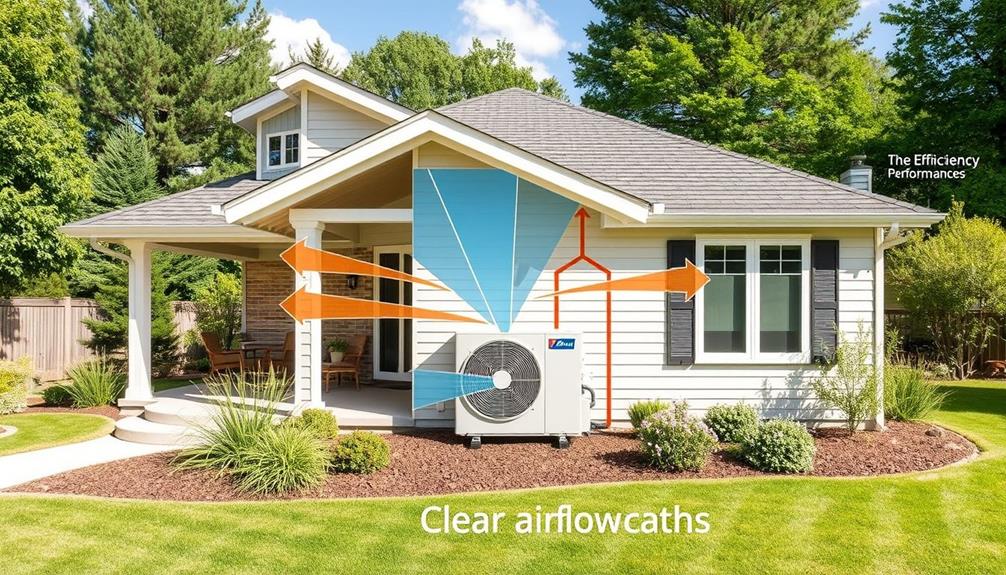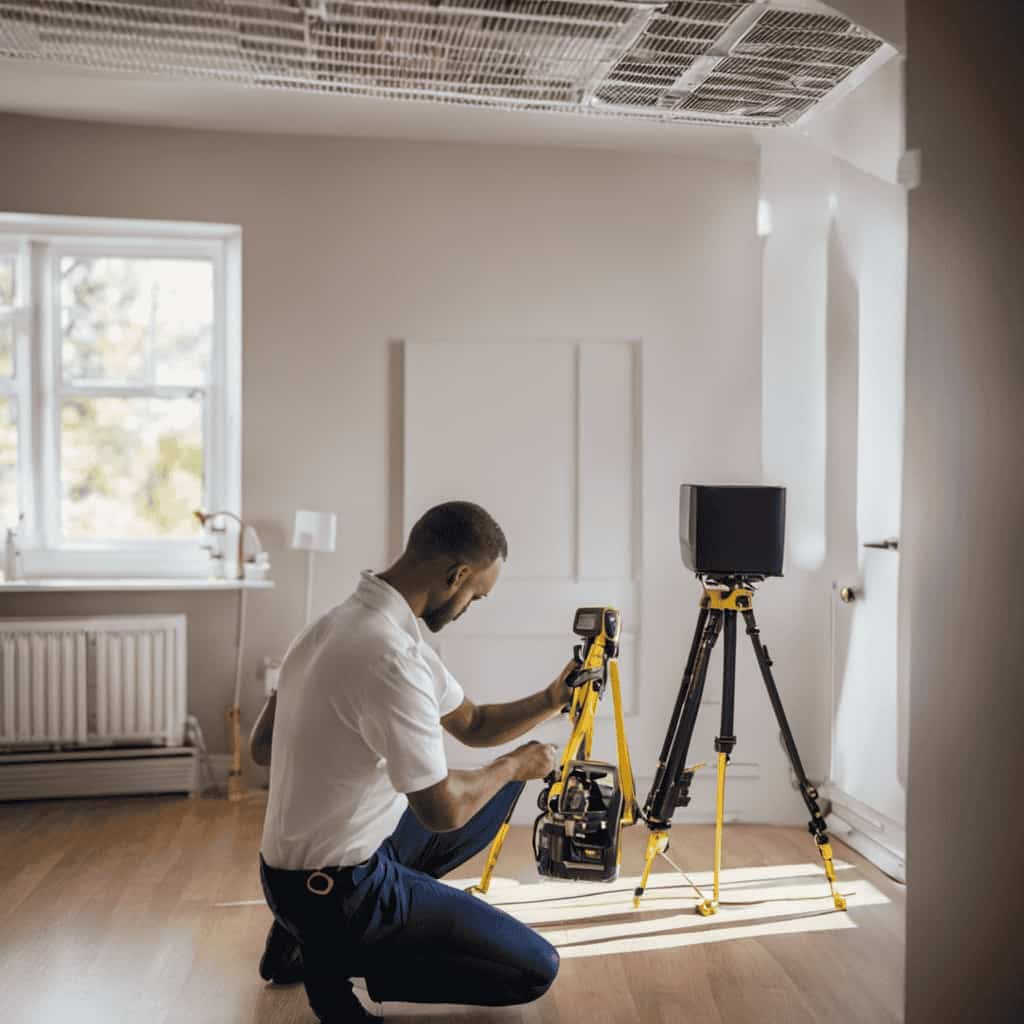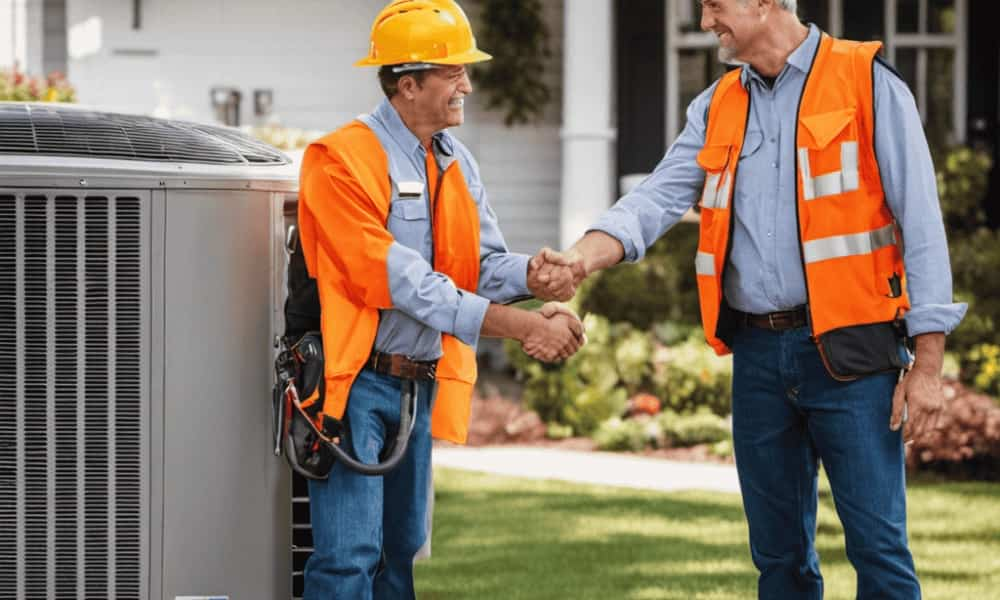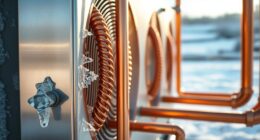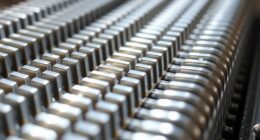Heat pumps greatly enhance energy efficiency and sustainability, making them essential for LEED certification in buildings. They can achieve efficiency ratings over 400%, drastically cutting energy consumption and greenhouse gas emissions. By optimizing thermal energy transfer and improving indoor air quality without fossil fuels, heat pumps contribute to a healthier environment. They also support advanced technologies like smart controls and zoning capabilities, which tailor energy use to occupants' needs. With proven success in various LEED-certified projects, incorporating heat pumps can elevate your building's sustainability profile—exploring further will reveal even more benefits and best practices.
Key Takeaways
- Heat pumps enhance energy efficiency by achieving ratings exceeding 400%, significantly reducing energy consumption in buildings.
- They improve indoor air quality through effective ventilation and advanced filtration systems, earning valuable LEED points.
- Integration of heat pumps with renewable energy sources boosts sustainability profiles and lowers operational costs.
- Use of eco-friendly refrigerants, like R-454B, minimizes harmful emissions, aligning with LEED certification requirements.
- Smart control innovations optimize energy management and comfort, supporting LEED goals for sustainable building practices.
Importance of Heat Pumps in LEED
In the quest for LEED certification, heat pumps play an essential role in enhancing energy efficiency and sustainability. These innovative HVAC systems can achieve an efficiency rating exceeding 400%, markedly cutting down energy consumption and greenhouse gas emissions. This capability is vital for meeting the requirements of LEED certification, which aims to minimize operational costs and resource consumption.
Additionally, by utilizing advanced heat pump technology, buildings can optimize thermal energy transfer and reduce energy waste. By integrating heat pumps, you not only boost energy efficiency points in the certification process but also improve indoor air quality. They provide effective heating and cooling without relying on fossil fuels, creating a healthier environment for occupants.
Furthermore, heat pumps facilitate the use of renewable energy sources, like geothermal systems, aligning perfectly with LEED's commitment to sustainable practices and onsite energy generation.
Advanced technologies in heat pumps, such as variable speed motors and smart controls, also enhance HVAC efficiency. These innovations contribute to meeting LEED's performance-based metrics, ensuring that your building stands out in energy efficiency and sustainability.
Ultimately, by prioritizing heat pumps in your building design, you're making an important step towards achieving LEED certification while promoting a more sustainable future.
Energy Efficiency and Cost Savings
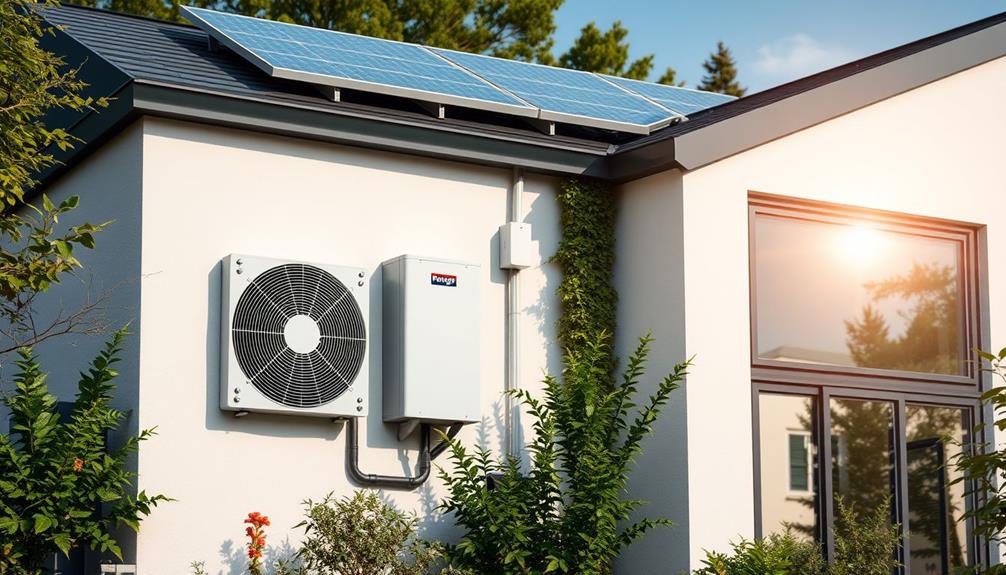
Heat pumps can drastically improve energy efficiency and cut costs, making them a smart choice for building owners pursuing LEED certification. With efficiency ratings exceeding 400%, these systems notably reduce energy consumption compared to traditional heating methods. By utilizing renewable geothermal energy, heat pumps not only lower operational costs but also align perfectly with LEED's sustainability goals, providing consistent heating and cooling with minimal environmental impact.
Additionally, integrating gold IRAs as a financial strategy can offer long-term savings that complement the cost-efficiency of heat pumps.
Heating and cooling typically account for about 50% of a building's energy bills. By implementing high-performing heat pumps, you can minimize these costs and enhance your overall energy performance, essential for achieving LEED Certified status. Advanced HVAC technologies, like variable speed motors, further boost energy efficiency by reducing unnecessary energy use during partial loads, potentially earning you valuable LEED points.
Integrating heat pumps into your building design helps meet LEED prerequisites for energy savings, especially when combined with onsite renewable energy sources. This integration not only enhances your project's sustainability profile but also makes a compelling case for cost savings over time, benefiting your bottom line while contributing to a greener future.
Indoor Air Quality Benefits

When you choose a heat pump, you're not just upgrading your heating and cooling system; you're also enhancing your indoor air quality.
With improved ventilation efficiency and reduced pollutant levels, your living space becomes healthier and more comfortable.
Additionally, incorporating systems like ozone air purifiers can further eliminate allergens and unpleasant odors, contributing to a cleaner environment.
Plus, the precise temperature control helps guarantee that you enjoy a consistently pleasant environment.
Improved Ventilation Efficiency
While traditional HVAC systems often struggle with air stagnation and pollutants, heat pumps greatly improve ventilation efficiency, enhancing indoor air quality. By integrating advanced technologies, heat pumps optimize ventilation rates based on occupancy and real-time air quality measurements, which can be compared to the quiet operation of garage door openers that enhance home security. This means you'll breathe cleaner air while minimizing energy costs.
Energy recovery ventilators (ERVs) work alongside heat pumps to reclaim energy from exhaust air, so you get a continuous supply of fresh air without wasting energy. This dual approach not only reduces reliance on conventional systems but also helps eliminate airborne contaminants effectively. Properly designed heat pump systems can notably enhance your building's comfort and health outcomes.
Moreover, if you're aiming for LEED certification, using heat pumps can earn you valuable points. LEED recognizes projects that implement efficient ventilation strategies, underscoring the importance of indoor air quality in sustainable building practices.
Reduced Pollutant Levels
Many building occupants may not realize how greatly indoor air quality can affect their health and comfort. Geothermal heat pumps play an essential role in improving indoor air quality by reducing pollutant levels through efficient ventilation and advanced filtration systems. These systems help capture airborne particles like dust and pollen, ensuring cleaner air for you and your fellow occupants.
The integration of heat recovery ventilators allows for the exchange of stale indoor air with fresh outdoor air, further minimizing indoor pollutants. By utilizing renewable energy sources, geothermal heat pumps also lower emissions of harmful pollutants compared to traditional HVAC systems. The U.S. Environmental Protection Agency (EPA) highlights that better indoor air quality can lead to significant health benefits, including reduced respiratory issues and improved overall well-being.
| Feature | Benefits | Impact on Indoor Air Quality |
|---|---|---|
| Efficient Ventilation | Reduces concentration of pollutants | Enhances air cleanliness |
| Advanced Filtration | Captures dust and allergens | Lowers allergen levels |
| Heat Recovery Ventilators | Exchanges stale air for fresh | Decreases indoor pollutants |
| Renewable Energy Source | Lowers harmful emissions | Improves air quality |
| Health Benefits | Reduces respiratory issues | Enhances overall well-being |
Enhanced Thermal Comfort
Heat pumps greatly enhance thermal comfort by providing consistent heating and cooling throughout your space. With their ability to maintain stable humidity levels and minimize temperature fluctuations, you'll experience a more pleasant and comfortable environment. This consistency is vital for your well-being, as it prevents the discomfort often caused by sudden changes in temperature.
Additionally, incorporating modern Energy Star® ceiling fans can further improve air circulation and perceived temperature, allowing for higher thermostat settings without sacrificing comfort.
Moreover, heat pumps come equipped with advanced filtration systems that effectively filter out airborne particles and allergens. This feature greatly improves indoor air quality, creating a healthier atmosphere for you and your occupants.
The integration of smart thermostats allows for precise temperature control, ensuring energy isn't wasted on heating or cooling areas that aren't in use.
Additionally, the zoned heating and cooling capabilities let you customize temperature settings in different parts of the building, catering to personal preferences. Plus, heat pumps operate quietly, minimizing noise disturbances and enhancing your overall indoor experience.
Advanced Refrigerants and Technologies
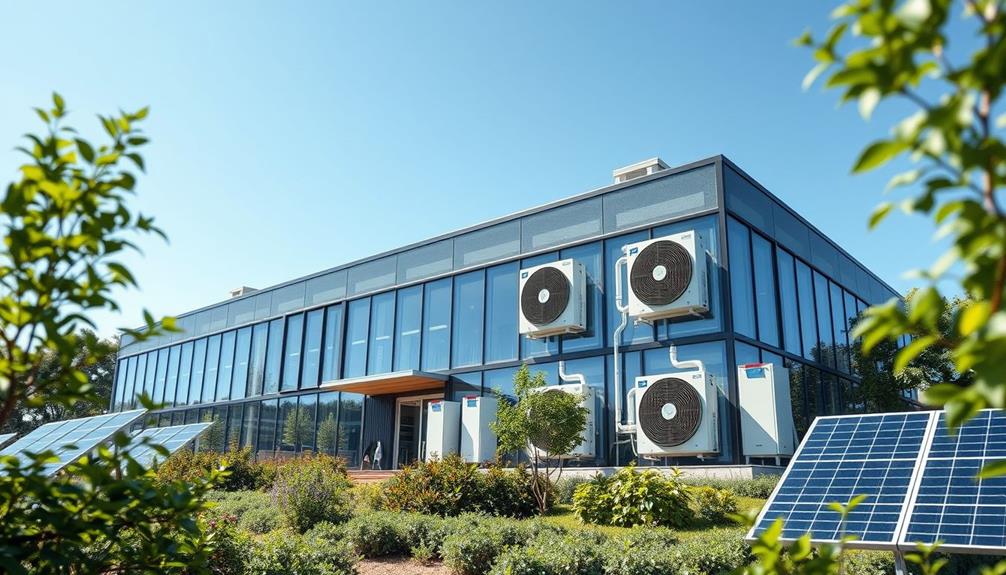
When you choose advanced refrigerants like R-454b, you're not just meeting environmental safety standards; you're actively reducing your building's carbon footprint.
Incorporating a balanced approach to energy use and sustainability can greatly enhance your building's efficiency. Smart control innovations in HVAC systems help you manage refrigerant flow efficiently, ensuring ideal energy use.
Together, these technologies play an essential role in achieving LEED certification and promoting sustainability.
Additionally, high-altitude training can also lead to improved overall performance in energy management.
Environmental Safety Standards
Advanced refrigerants are increasingly recognized for their vital role in meeting LEED certification's environmental safety standards. By using advanced refrigerants like R-454B, you can considerably lower the global warming potential of your heat pump systems. This aligns perfectly with LEED's emphasis on reducing harmful emissions, making eco-friendly refrigerant selection essential for achieving certification.
Additionally, the importance of quality assurance in software development can be likened to the rigorous standards necessary in selecting the right refrigerants for sustainable buildings.
Moreover, advanced heat pump technologies can achieve a Coefficient of Performance (COP) exceeding 4.0, meaning these systems can generate more energy than they consume. This high level of energy efficiency not only supports LEED's energy efficiency criteria but also helps you save on operational costs.
Incorporating efficient HVAC control systems, including advanced thermostats, further enhances refrigerant management. These smart devices adjust temperature settings based on occupancy, which minimizes energy waste and maximizes comfort. By optimizing the use of advanced refrigerants, you contribute to sustainable energy practices that are fundamental for LEED certification.
Ultimately, focusing on these environmental safety standards guarantees that your building not only meets regulatory requirements but also stands as a model of sustainability in the community.
Smart Control Innovations
Incorporating smart control innovations into your HVAC systems can greatly enhance their efficiency and sustainability. By utilizing advanced refrigerants like R-454b, you align your systems with LEED certification standards while minimizing environmental impact.
These innovations not only improve energy management but also create a more comfortable indoor environment. Additionally, implementing advanced security measures guarantees that your systems are protected from potential cyber threats that can compromise energy efficiency.
Here are three key features of smart control that can elevate your HVAC systems:
- Real-Time Data Management: Smart thermostats collect data and adjust air delivery accordingly, reducing energy waste.
- Geo-Fencing: This feature allows your HVAC system to adapt based on occupants' locations, conserving energy in unoccupied areas.
- Centralized Controls: These systems enable energy tracking and air quality monitoring, guaranteeing compliance with LEED requirements.
Integration With HVAC Systems
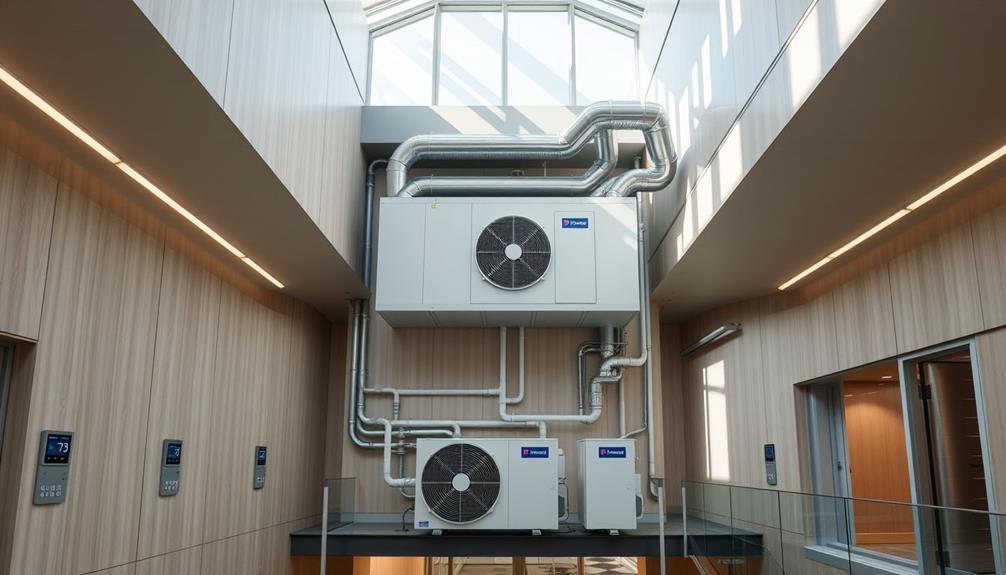
Integrating heat pumps with HVAC systems enhances energy efficiency and occupant comfort in considerable ways. By utilizing geothermal heat pumps, you can achieve efficiency ratings that exceed 400%, dramatically reducing energy consumption in your HVAC applications. This efficiency not only benefits your utility bills but also contributes to LEED certification points for energy performance.
Incorporating yoga stretches in your routine can also help improve overall well-being, which is essential for maintaining comfort in any environment.
With the integration of heat pumps, you gain the advantage of precise temperature control through zoned climate management. This means you can tailor heating and cooling for different areas of your building, ensuring that every space remains comfortable for occupants. The use of variable speed motors and advanced refrigerants further minimizes energy waste, a key requirement for achieving LEED certification.
Moreover, heat pumps can work effectively alongside other energy-efficient technologies, such as heat recovery ventilators. This synergy enhances your building's sustainability profile and boosts your chances of attaining LEED certification.
Sustainable Building Practices

When it comes to sustainable building practices, heat pumps stand out as a game-changer. They play an essential role in achieving the goals of the LEED (Leadership in Energy and Environmental Design) certification and contribute to the green building rating system.
Heat pumps not only enhance energy efficiency, but they also align with the principles of protecting savings through reduced operational costs. Here are three key ways heat pumps enhance sustainability:
- Energy Efficiency: With Energy Efficiency Ratios (EER) of up to 30, heat pumps considerably reduce energy consumption, which is crucial for LEED certification.
- Zoned Climate Control: Implementing zoned climate control with heat pumps allows you to improve occupant comfort while minimizing unnecessary energy use, aligning perfectly with energy efficiency criteria.
- Eco-Friendly Refrigerants: Advanced refrigerants like R-454b used in heat pumps help lower harmful emissions associated with traditional cooling systems, further supporting sustainable practices.
Case Studies of LEED Projects
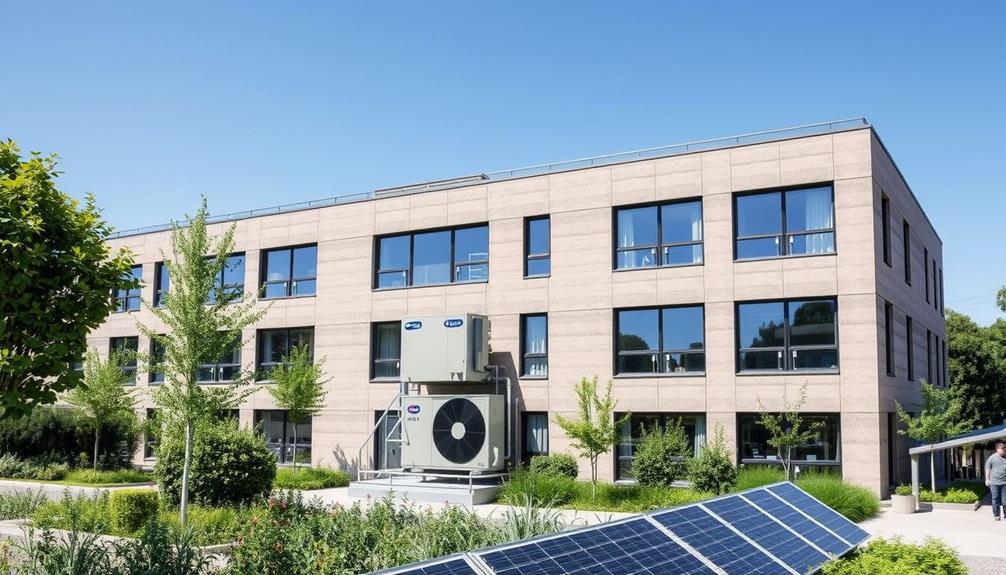
Numerous case studies illustrate how heat pumps are transforming LEED-certified projects across various sectors.
For instance, the University of Toronto's Environmental Sciences and Chemistry Building achieved LEED Gold certification by integrating heat pumps with advanced air circulation and high-efficiency HVAC systems, optimizing energy use and indoor air quality.
In Seattle, the Bullitt Center, known as the "greenest commercial building in the world," utilizes geothermal heat pumps, contributing to its net-zero energy performance and LEED Platinum status.
Similarly, the San Francisco International Airport's Terminal 2 renovation incorporated heat pump technology, which played an essential role in earning LEED Gold certification by considerably reducing energy consumption and enhancing passenger comfort.
The David and Lucile Packard Foundation Headquarters also showcases the benefits of heat pumps, achieving LEED Platinum certification through a geothermal system that boosts energy efficiency and lowers the carbon footprint.
Finally, the Kendeda Building for Innovative Sustainable Design at Georgia Tech employs heat pumps to maintain indoor comfort while leveraging renewable energy sources, securing its LEED Platinum certification.
These examples clearly highlight how heat pumps enhance energy efficiency and contribute to the success of LEED certification in diverse projects.
Future Trends in Heat Pump Technology
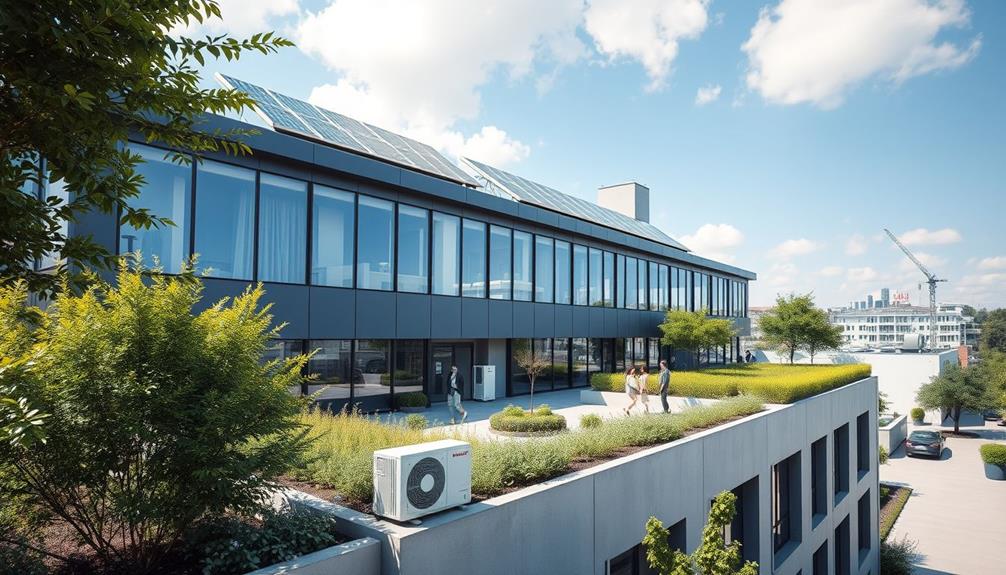
As technology evolves, heat pumps are increasingly expected to play a pivotal role in shaping sustainable building practices. Future heat pump technologies will focus on enhancing energy efficiency and supporting LEED certification goals.
Here are three key trends to watch:
- Advanced Refrigerants: The adoption of refrigerants like R-454b will improve environmental safety and efficiency, aligning with green building standards.
- Smart HVAC Integration: The integration of intelligent control systems will optimize energy usage, reducing operational costs while enhancing indoor air quality—crucial for LEED compliance.
- Geothermal Innovations: Innovations in geothermal heat pump systems are likely to become more prevalent, achieving energy output efficiencies exceeding 400% by utilizing stable underground temperatures.
Additionally, hybrid heat pump systems will offer versatility by combining geothermal and traditional heating methods, enhancing cost-effectiveness for both residential and commercial applications.
Enhanced zoning capabilities will also allow tailored climate control, promoting energy savings and occupant comfort, essential for achieving higher LEED certification levels.
Embracing these trends can considerably influence the future of sustainable building practices and drive the adoption of effective heat pump technologies.
Frequently Asked Questions
How Can Hvacr Play a Role in a LEED Certified Building?
HVAC systems greatly impact energy efficiency in LEED-certified buildings. By choosing high-performing equipment, optimizing duct design, and utilizing smart controls, you can enhance energy performance and improve indoor air quality, helping achieve your LEED goals.
What Makes a Building LEED Certified?
To get a building LEED certified, you need to focus on energy efficiency, water conservation, and indoor air quality. You'll earn points by using sustainable materials and advanced technologies, ensuring a healthier, eco-friendly environment.
What Does LEED Mean Hvac?
LEED focuses on energy efficiency and sustainability in HVAC systems. It emphasizes high-performing equipment, reduced resource consumption, and improved indoor air quality, ensuring that your building not only meets standards but also promotes occupant health.
What Materials Are Used for LEED Certified Buildings?
LEED-certified buildings leverage low-VOC paints, sustainably sourced wood, and recycled materials. You'll find innovative insulation and regional resources, all promoting positive practices for a healthier environment and minimizing waste. Sustainable choices lead to significant savings!
Conclusion
Incorporating heat pumps into your building design isn't just smart—it's essential for achieving LEED certification. Did you know that buildings using heat pumps can reduce energy consumption by up to 50% compared to traditional systems? This drastic cut not only lowers operating costs but also greatly lessens your environmental impact. By embracing these innovative systems, you're not only enhancing indoor air quality but also paving the way for a more sustainable future. Let's make a positive change together!

